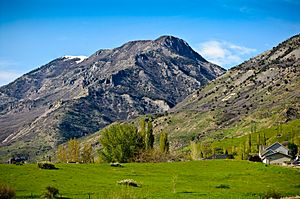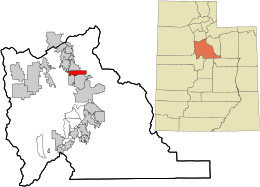Lindon, Utah facts for kids
Quick facts for kids
Lindon, Utah
|
|
|---|---|

The Wasatch mountain range north of Lindon
|
|

Location in Utah County and the state of Utah
|
|
| Country | United States |
| State | Utah |
| County | Utah |
| Settled | 1850 |
| Incorporated | March 24, 1924 |
| Named for | Linden tree |
| Area | |
| • Total | 8.54 sq mi (22.11 km2) |
| • Land | 8.35 sq mi (21.63 km2) |
| • Water | 0.19 sq mi (0.48 km2) |
| Elevation | 4,666 ft (1,422 m) |
| Population
(2010)
|
|
| • Total | 10,070 |
| • Density | 1,329.34/sq mi (513.27/km2) |
| Time zone | UTC-7 (Mountain (MST)) |
| • Summer (DST) | UTC-6 (MDT) |
| ZIP code |
84042
|
| Area code(s) | 801 |
| FIPS code | 49-45090 |
| GNIS feature ID | 2410838 |
| Website | www.lindoncity.org |
Lindon is a city located in Utah County, Utah, in the United States. It is part of the larger Provo–Orem metropolitan area. In 2010, about 10,070 people lived there. By July 2019, the population was estimated to be around 11,100.
Contents
Lindon's Early Days
Lindon was first settled in 1861 by pioneers. They moved into an area that was mostly grazing land. The town was first called "String Town." This was because the houses were spread out along the road between the towns of Orem and Pleasant Grove.
In 1901, an old linden tree in town inspired the city's current name. The name "Lindon" is actually a slight misspelling of "linden." Even with its growth, Lindon tries to keep its motto: "Lindon: a little bit of country."
Historic Places to See
Lindon has several interesting historical sites that tell stories of its past.
Gillman Farm
The Gillman Farm is located at 584 W. Gillman Lane. James Henry Gillman bought 10 acres (4 hectares) of land here a long time ago. Today, four generations of the Gillman family still work and care for this farm. It has been recognized as one of Utah's "Century Farms."
Lindon Cider Mill
You can find the Lindon Cider Mill at 395 N. State St. Lewis Robison built it in 1857. This mill made cider for the people of Lindon every fall and winter. In the summer, they would use the aged cider as vinegar. The mill still stands today with its original stone walls. The stone came from American Fork Canyon.
Alfred Harper House
The Alfred Harper House, also known as the "Big House," is at 125 W. 400 N. It was built in 1876 using unique honeycomb limestone from American Fork Canyon. Alfred Harper built the house before going on a three-year mission. When he returned, he finished the home and planted vines that now cover the house. This is the only property in Lindon listed on the National Register of Historic Places.
Lindon Ward Chapel
The Lindon Ward Chapel was located at 400 N and Main. Early members of LDS Church built it in the late 1800s. The chapel was dedicated in 1891. Today, the original iron fence and pine trees still mark where the church once stood.
Lindon Elementary School
The first Lindon Elementary School was built in 1900 for $5,200. It was located at Main and Center Street. The school was later torn down in 1966. A new school was built in November 1967 for $510,000.
Geneva Resort
Captain John Dallin named the Geneva Resort after his daughter in 1890. It was located at 2130 W. 600 S. He built a boat harbor, wells, a dance pavilion, a hotel, and places to buy snacks.
Joseph Wadley Farm
The Joseph Wadley Farm is at 67 E. 400 N. In 1881, Joseph Wadley started getting tufa rock from Pleasant Grove. He built his home on 32 acres (12.9 hectares) of land in 1882. In 1988, his grandson bought the land and brought it back to its original look.
The Amusement Hall
The Amusement Hall was built in 1900 at 150 N. State St. It was shaped like a "T" and made of rustic wood. People used the hall for plays, silent movies, and dancing. In 1940, it was changed into a cannery.
Memorial Sites
Lindon also has places that remember important people and events.
Pioneer Home
The Pioneer Home is at 150 S. 500 E. This restored house belonged to the first settlers who came to Lindon in 1861.
Lindon City Veteran's Memorial
The Lindon City Veteran's Memorial is located at 200 N. State Street. This memorial honors those who fought and died in wars during the 20th century. It includes photos and stories of those who gave their lives for their country.
Lindon's Geography
Lindon is a city with a total area of about 8.6 square miles (22.2 square kilometers). Most of this area, about 8.4 square miles (21.8 square kilometers), is land. The rest, about 0.2 square miles (0.5 square kilometers), is water.
People of Lindon
| Historical population | |||
|---|---|---|---|
| Census | Pop. | %± | |
| 1930 | 589 | — | |
| 1940 | 587 | −0.3% | |
| 1950 | 801 | 36.5% | |
| 1960 | 1,150 | 43.6% | |
| 1970 | 1,644 | 43.0% | |
| 1980 | 2,796 | 70.1% | |
| 1990 | 3,818 | 36.6% | |
| 2000 | 8,363 | 119.0% | |
| 2010 | 10,070 | 20.4% | |
| 2019 (est.) | 11,100 | 10.2% | |
| U.S. Decennial Census | |||
In 2010, Lindon had 10,070 people living in 2,518 households. Most people (91.8%) were White. Other groups included African American, Native American, Asian, and Pacific Islander people. About 7.1% of the population was Hispanic or Latino.
Many households (56.8%) had children under 18 living with them. The average household had about 4 people. The median age in the city was 26.3 years old. This means half the people were younger than 26.3 and half were older.
The median income for a household in Lindon was about $61,964. This means half the households earned more than this, and half earned less. About 3.1% of the population lived below the poverty line.
Schools in Lindon
Lindon's public schools are part of the Alpine School District. The superintendent of schools is Sam Jarman.
See also
 In Spanish: Lindon (Utah) para niños
In Spanish: Lindon (Utah) para niños


